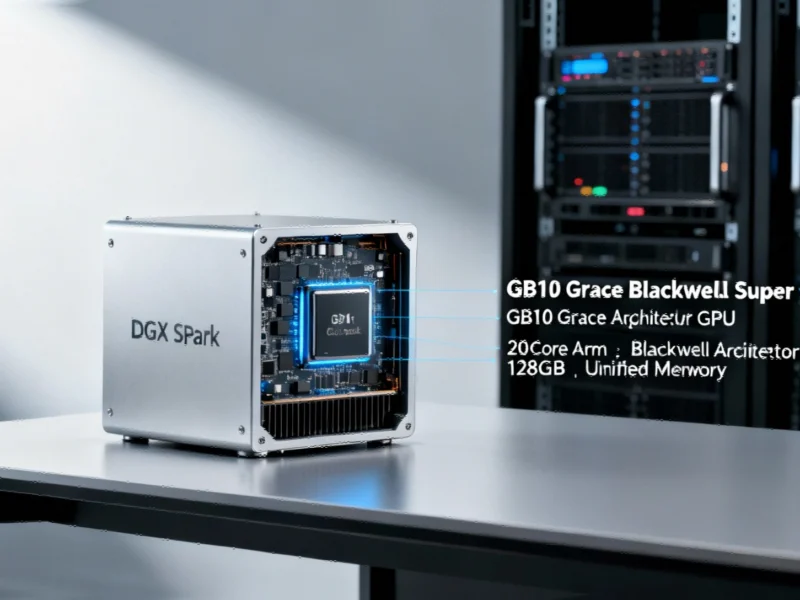Desktop AI Power Arrives
Nvidia has fundamentally altered the artificial intelligence development landscape with the October 15, 2025, shipment commencement of its DGX Spark system, bringing data center-class AI capabilities to desktop environments at a $3,999 price point. This compact 150mm square device represents a strategic shift in how organizations approach AI development, offering an intermediate solution between cloud GPU rentals and full server infrastructure. The timing proves critical as enterprises transition from experimental AI projects to full production implementations requiring iterative development cycles. According to industry analysis from EAM Vision Direct, this development marks a significant milestone in making advanced AI capabilities accessible beyond traditional data center environments.
The emergence of desktop AI systems coincides with broader technological shifts across multiple sectors. As mobile technology continues advancing with devices like the OnePlus 15, and renewable energy infrastructure expands with projects like the Malmesbury solar plant expansion, the computational demands for AI development are similarly evolving toward more accessible formats.
Technical Architecture Breakthrough
At the heart of DGX Spark’s capability lies the GB10 Grace Blackwell superchip, integrating a 20-core Arm processor with Blackwell architecture GPU sharing 128GB of unified memory. This memory architecture represents a fundamental departure from traditional discrete GPU configurations, eliminating the performance overhead of data transfers between separate CPU and GPU memory pools. The unified approach enables loading entire large language models directly into memory, significantly reducing the bottlenecks that typically constrain model inference performance.
The system delivers one petaflop of compute at FP4 precision, equivalent to 1,000 trillion floating-point operations per second. This theoretical peak performance leverages 4-bit precision and sparsity optimization specifically tailored for AI workloads. However, real-world performance varies considerably based on model architecture and precision requirements, with independent benchmarks identifying the 273 gigabytes per second memory bandwidth as the primary constraint for inference workloads.
Connectivity and Expansion Capabilities
Networking features span both consumer and enterprise-grade options, including Wi-Fi 7 and 10 gigabit ethernet alongside dual QSFP56 ports connected through an integrated ConnectX-7 smart network interface card. These high-speed ports theoretically support 200 gigabits per second aggregate bandwidth, though practical throughput faces limitations from PCIe generation 5 lane constraints. The connectivity options enable sophisticated deployment scenarios, particularly when considering the broader infrastructure challenges highlighted by reported fiber optic shortages affecting data center development.
For handling larger models, two DGX Spark units can connect via QSFP ports to manage models up to 405 billion parameters through distributed inference. This configuration requires either direct cable connection or enterprise-grade 200 gigabit ethernet switches, with compatible switching infrastructure typically exceeding $35,000—a significant additional investment that organizations must factor into total cost calculations.
Ecosystem and Software Environment
The device operates on DGX OS, Nvidia’s customized Ubuntu Linux distribution preconfigured with CUDA libraries, container runtime, and AI frameworks including PyTorch and TensorFlow. This closed ecosystem approach ensures software compatibility across Nvidia’s platform but limits flexibility compared to general-purpose workstations. Users cannot install alternative operating systems like Windows or utilize the hardware for non-AI workloads such as gaming, positioning the device squarely as a specialized development tool rather than a versatile workstation.
The specialized nature of AI development hardware reflects broader trends in industrial technology, where specialized financing and supplier vetting become increasingly critical for technology adoption across multiple sectors.
Real-World Deployment Scenarios
Primary use cases center around model prototyping, where developers iterate on AI architectures before cloud deployment, and fine-tuning of models between 7 billion and 70 billion parameters. The system also handles batch inference workloads such as synthetic data generation and computer vision applications, enabling organizations to conduct local model training and testing before edge deployment. This local development approach aligns with increasing concerns about global trade uncertainties affecting technology supply chains and data sovereignty requirements.
Dell’s positioning of its version toward edge computing deployments rather than desktop development highlights the divergent market interpretations of the technology’s primary value proposition. The edge computing angle targets scenarios requiring local inference with minimal latency, such as industrial automation or remote facility deployments where cloud connectivity proves unreliable or impractical.
Competitive Landscape and Alternatives
Organizations considering DGX Spark must evaluate alternative approaches to similar computational requirements, including building workstations with multiple consumer GPUs, purchasing Mac Studio configurations with comparable unified memory, or maintaining cloud GPU subscriptions. Four Nvidia RTX 3090 GPUs provide greater aggregate memory and inference throughput at similar total cost, though with higher power consumption and larger physical footprint. The Mac Studio M4 Max configuration delivers 128GB unified memory with superior bandwidth characteristics starting at $4,400, though with different architectural advantages.
The decision-making process for such technology investments occurs within a broader economic context, where financial considerations and regulatory environments significantly influence technology adoption timelines.
Adoption Patterns and Market Reception
Early adoption signals two weeks after general availability remain limited but targeted, with research institutions, AI software companies including Anaconda and Hugging Face, and technology vendors conducting compatibility testing among the initial recipients. The broader enterprise adoption patterns will ultimately determine whether the device addresses genuine operational needs or represents a niche product for specific development workflows.
Nvidia’s launch partners including Acer, Asus, Dell Technologies, Gigabyte, HP, Lenovo and MSI have begun shipping customized versions of the hardware. Acer’s Veriton GN100 matches the reference specification at the same $3,999 price point with regional availability across North America, Europe and Australia, indicating confidence in global market demand despite the specialized nature of the product.
Strategic Implications and Future Outlook
The DGX Spark demonstrates Nvidia’s vertical integration across silicon design, system architecture and software platforms, providing organizations with a tested platform for AI development featuring guaranteed compatibility across Nvidia’s ecosystem. Whether the $3,999 investment delivers sufficient value depends entirely on individual development workflows, data residency requirements and existing infrastructure constraints.
Technology decision makers must evaluate total cost of ownership including the base hardware investment, potential switch infrastructure for multi-unit configurations and opportunity cost versus cloud alternatives. A single DGX Spark running continuously for model fine-tuning costs $3,999 upfront, while equivalent cloud GPU hours range from $1 to $5 per hour for comparable specifications. Organizations running intensive development workflows for six to twelve months may reach cost parity with cloud alternatives, making the economic case highly dependent on specific usage patterns and development timelines.
As AI development continues evolving toward more accessible formats, the DGX Spark represents a significant step in democratizing advanced computational capabilities while maintaining the performance characteristics necessary for serious development work. The system’s limitations—particularly the memory bandwidth constraints and closed software ecosystem—nevertheless ensure it serves as a development platform rather than production infrastructure, with teams prototyping and optimizing models locally before deploying to cloud platforms or on-premises server clusters for production inference.
Based on reporting by {‘uri’: ‘forbes.com’, ‘dataType’: ‘news’, ‘title’: ‘Forbes’, ‘description’: ‘Forbes is a global media company, focusing on business, investing, technology, entrepreneurship, leadership, and lifestyle.’, ‘location’: {‘type’: ‘place’, ‘geoNamesId’: ‘5099836’, ‘label’: {‘eng’: ‘Jersey City, New Jersey’}, ‘population’: 247597, ‘lat’: 40.72816, ‘long’: -74.07764, ‘country’: {‘type’: ‘country’, ‘geoNamesId’: ‘6252001’, ‘label’: {‘eng’: ‘United States’}, ‘population’: 310232863, ‘lat’: 39.76, ‘long’: -98.5, ‘area’: 9629091, ‘continent’: ‘Noth America’}}, ‘locationValidated’: False, ‘ranking’: {‘importanceRank’: 13995, ‘alexaGlobalRank’: 242, ‘alexaCountryRank’: 114}}. This article aggregates information from publicly available sources. All trademarks and copyrights belong to their respective owners.



